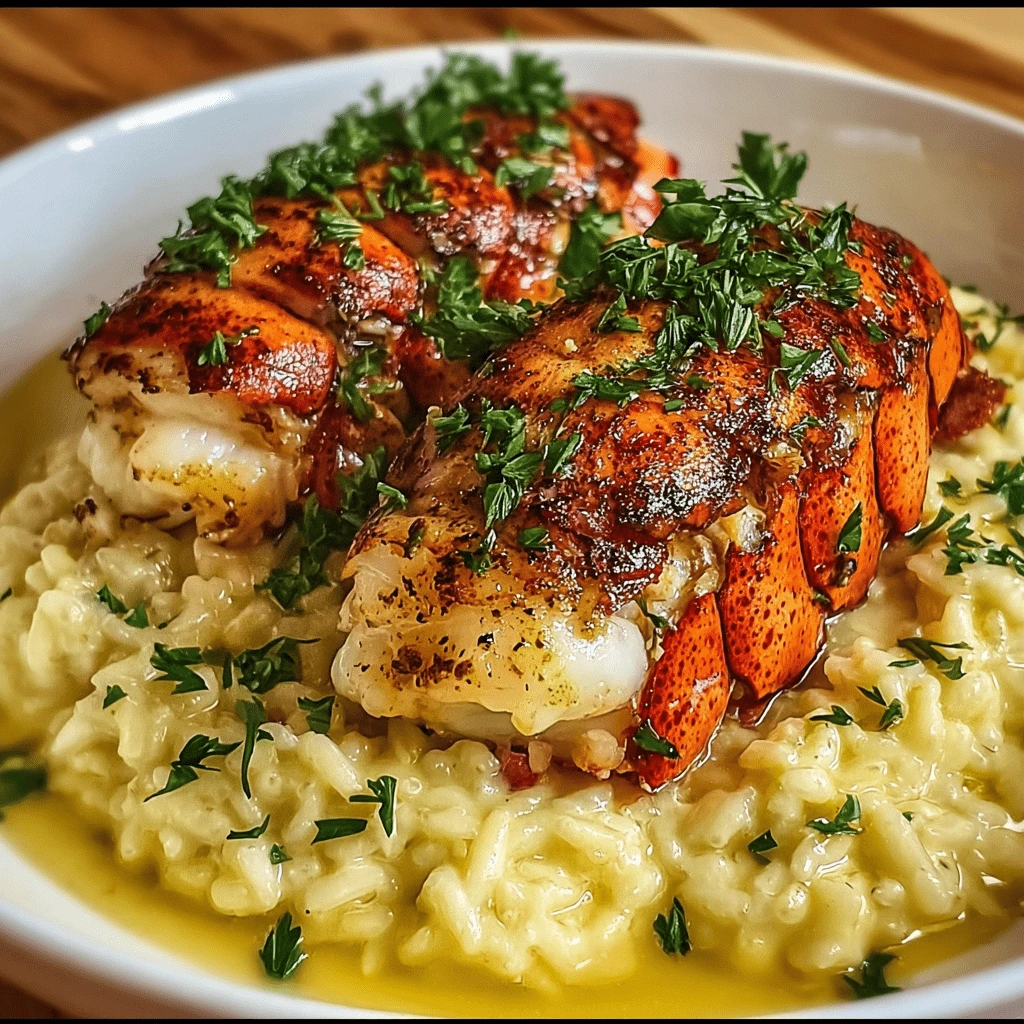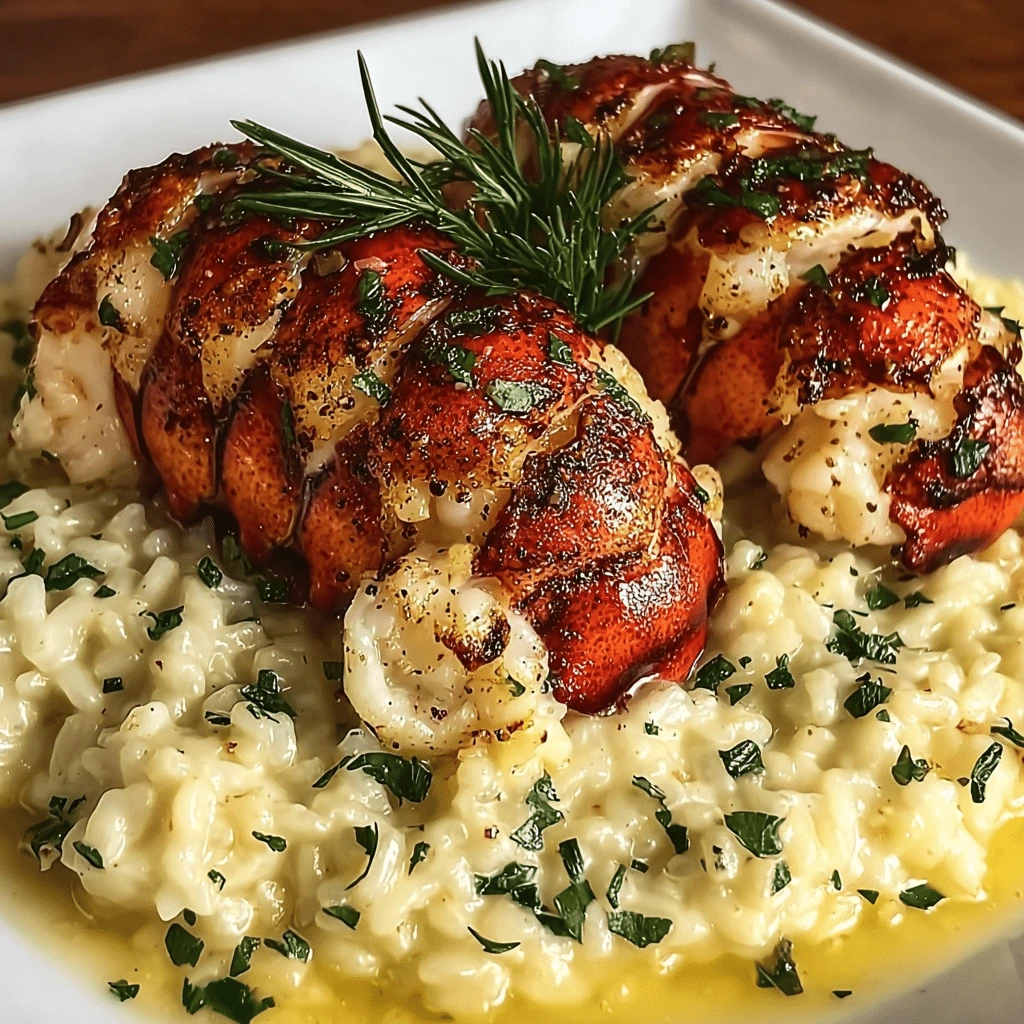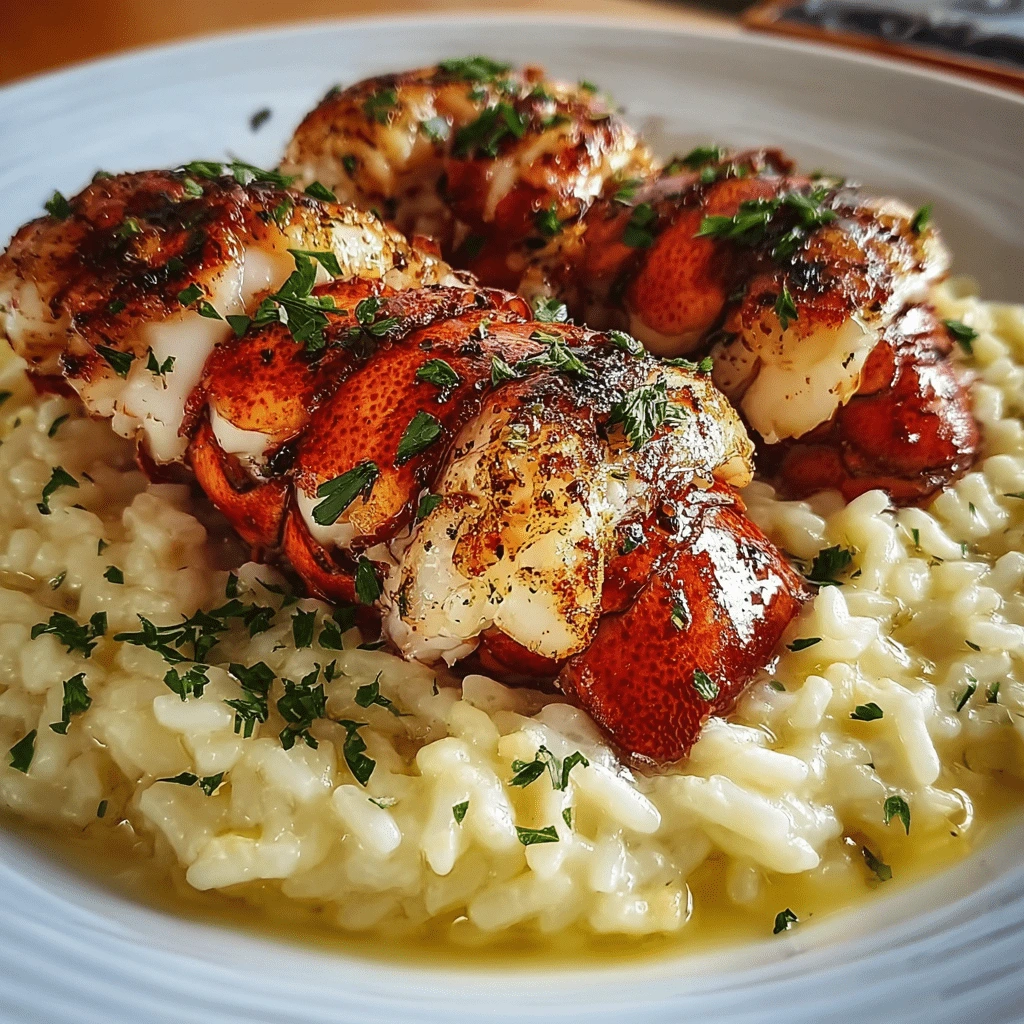Looking for a gourmet dinner recipe that blends decadent flavors with restaurant-quality presentation? This guide to butter-poached lobster tails with creamy risotto is everything you need. With tender lobster tails poached in rich garlic butter and served over a luscious Parmesan risotto, this dish is an elegant crowd-pleaser perfect for celebrations or special nights at home.
Whether you’re hosting a romantic dinner or simply want to impress your guests with refined flavors, this recipe promises a high-end experience with accessible techniques. In this comprehensive guide, we’ll walk you through every step — from selecting the best ingredients to mastering culinary techniques that elevate this dish.
Before diving into the method, let’s understand why this seafood and rice pairing is such a timeless gourmet combination.
🍽️ Why butter-poaching is the best method for lobster
Among various cooking methods like boiling, grilling, or steaming, butter-poaching stands out for preserving the delicate sweetness and tenderness of lobster. When lobster is submerged in warm, infused butter — known as a beurre monté — it absorbs flavor without becoming rubbery or overcooked.
This low-and-slow method is widely celebrated in fine dining. It uses gentle heat and fat to slowly cook lobster tails to perfection, giving them a buttery richness that enhances their natural flavor.
Butter-poaching also gives you more control over texture. Unlike boiling, which can shock the meat and cause it to toughen, poaching in butter allows for even, controlled cooking.
The technique is rooted in French cuisine, which traditionally champions poaching as a way to preserve moisture and intensify flavor. For a deeper dive into this method, check out this helpful overview of poaching techniques from Wikipedia.
To see how beautifully this method showcases seafood, explore Pinterest’s butter-poached seafood inspiration, which displays stunning variations that highlight this exact technique.
🛒 Selecting quality lobster tails for poaching
Choosing high-quality lobster tails is crucial to making this dish successful. Whether you’re buying fresh or frozen, the right selection ensures the meat is sweet, firm, and tender once cooked.
Here’s what to look for when shopping:
-
Color: Raw lobster tails should be grayish or translucent, not yellowing or off-color.
-
Scent: They should smell clean like the sea — never fishy or sour.
-
Shell condition: Cracks, dry spots, or discoloration indicate poor storage.
For ethical sourcing, consider buying sustainably harvested lobster, which supports marine ecosystems. Check the packaging for certifications like MSC (Marine Stewardship Council) or opt for local fishmongers with traceable sourcing.
Ideal tail size is between 4 to 6 ounces per piece — large enough to stay juicy but small enough to cook evenly. Learn more about lobster anatomy and meat quality on the Wikipedia page for lobster, which offers valuable insight into choosing cuts.
For serving inspiration, check out these elegant lobster tail presentations on Pinterest. Presentation is half the dining experience, and this board will guide you visually.

🥘 Ingredients overview and smart substitutions
Creating this dish doesn’t require a professional kitchen — just a few thoughtful ingredients that work together to deliver luxurious taste.
For the lobster:
-
4 lobster tails, shells removed
-
1 cup unsalted butter
-
2 garlic cloves, minced
-
Juice of 1 lemon
-
Salt and pepper, to taste
-
Fresh parsley, chopped (for garnish)
For the risotto:
-
1 cup arborio rice
-
4 cups chicken or seafood stock, kept warm
-
1 small onion, finely diced
-
2 tablespoons olive oil
-
2 tablespoons unsalted butter
-
1/3 cup grated Parmesan cheese
-
Salt and pepper, to taste
If you need to make substitutions:
-
Use vegetable stock in place of seafood/chicken stock for a pescatarian version.
-
Skip the Parmesan if dairy-free, or try nutritional yeast for a similar umami profile.
-
Add mushrooms, peas, or even asparagus to make it seasonal.
-
For a full guide to arborio rice’s creamy cooking characteristics, read the Wikipedia page on arborio rice.
And if you’re visually inclined, Pinterest’s risotto plating board can help you nail the final aesthetic presentation.
🔪 Prepping lobster tails: a step-by-step guide
Before poaching, you’ll need to prep the lobster tails properly for even cooking and enhanced flavor absorption.
Steps to prepare lobster tails:
-
Remove shells: Use kitchen shears to cut down the top shell, then gently pull the meat out while keeping it attached at the base.
-
Devein: Check the underside for any dark vein and remove it with a knife.
-
Rinse and pat dry: Any residue can affect flavor and texture.
Allow lobster tails to sit at room temperature for 10–15 minutes before cooking — this prevents them from tightening up in the pan.
Uniformity is key. If the tails are drastically different in size, poach them in separate batches to avoid overcooking the smaller ones.
🧈 Butter-poaching lobster tails
This is where the magic happens. The key is low heat, gentle cooking, and constant basting.
Instructions:
-
In a large skillet, melt 1 cup of unsalted butter over low heat.
-
Stir in 2 cloves of minced garlic and juice from 1 lemon.
-
Add the lobster tails and poach them for 7–8 minutes, spooning butter over them frequently.
-
Watch closely: lobster is done when it turns opaque and slightly curls.
-
Remove, season with salt and pepper, and keep warm.
The goal is to keep the butter from browning. If you’re not confident about butter temperature, consider making clarified butter, which has a higher smoke point and maintains stability during longer cooking times.
Serve this up with flair, using the Pinterest gallery of gourmet dinner ideas as a visual reference.

🍚 Preparing the creamy risotto
Risotto is known for its luxurious, velvety texture, and cooking it correctly requires patience and rhythm.
Step-by-step risotto process:
-
Heat olive oil and 2 tablespoons butter in a pan over medium heat.
-
Sauté finely diced onions until translucent — about 5 minutes.
-
Stir in the arborio rice and toast lightly for 2–3 minutes, until the edges of the rice look translucent.
-
Gradually add warm stock, one ladle at a time, stirring constantly.
-
Wait until each addition is absorbed before adding more. This process takes about 18–20 minutes.
-
Stir in Parmesan cheese, salt, and pepper at the end.
The secret to creamy risotto lies in the slow addition of stock and the release of starch from arborio rice. For background on this cooking style, see risotto’s origin and technique.
To finish, explore garnish options on Pinterest’s risotto board, which showcases how herbs, textures, and colors can make this dish shine.
🍽️ Plating and presentation tips
Your meal deserves restaurant-quality presentation. Great plating doesn’t require a culinary degree — just attention to balance and texture.
Presentation tips:
-
Use a shallow bowl or plate to contain the risotto.
-
Spoon a generous mound of risotto in the center.
-
Place the butter-poached lobster tail gently on top.
-
Drizzle extra garlic butter over the lobster.
-
Garnish with chopped parsley and a few microgreens or edible flowers for color.
Visit this Pinterest plating guide for visual examples that balance elegance and simplicity.
🥂 Serving suggestions and pairings
This rich dish pairs well with lighter sides and crisp beverages that cleanse the palate.
Ideal side dishes:
-
Arugula salad with lemon vinaigrette
-
Roasted asparagus or green beans
-
Crusty artisan bread with garlic oil
Non-alcoholic drinks:
-
Sparkling water with citrus
-
Cucumber mint spritz
-
Fresh lemonade
For more pairing inspiration, this Pinterest board of date night meals offers well-curated ideas for side dishes and ambiance.
🧊 Storage and reheating tips
To store and enjoy leftovers without compromising flavor:
-
Storage: Keep risotto and lobster in separate airtight containers. Refrigerate for up to 2 days.
-
Reheating risotto: Add a splash of broth and reheat gently in a saucepan over low heat.
-
Reheating lobster: Wrap in foil and warm at 275°F for 10 minutes to avoid drying out.
Avoid microwaving lobster directly — it will turn rubbery. Always use low, even heat.
🧮 Nutritional breakdown
Here’s a general nutrition guide based on one serving (serves 4):
| Nutrient | Amount (per serving) |
|---|---|
| Calories | 620 kcal |
| Protein | 34 g |
| Carbohydrates | 42 g |
| Fat | 38 g |
| Saturated Fat | 19 g |
| Fiber | 1 g |
| Sodium | 650 mg |
This dish is rich in healthy fats and protein, but can be modified with low-fat cheese or vegetable broth for lighter versions.
🧑🍳 Variations and recipe twists
If you’re looking to customize the dish, try these creative options:
-
Lobster and truffle risotto: Add a drizzle of truffle oil just before serving.
-
Cajun twist: Season the lobster with Cajun spice before poaching.
-
Vegetable risotto: Add roasted corn, peas, or mushrooms for extra texture.
-
Seafood swap: Substitute with scallops or shrimp if lobster is unavailable.
Pinterest has a great lobster risotto variations board to inspire more flavor twists.

❓ FAQs: People also ask
Can you poach lobster in butter?
Yes, it’s one of the best techniques for keeping the meat moist and tender without overcooking.
What is the secret to creamy risotto?
Patience and technique — adding warm broth gradually and stirring constantly allows starch to release slowly for creaminess.
How do you not overcook lobster tails?
Poach gently over low heat and watch for a color change to opaque. Use a thermometer for precision (135–140°F).
Can you make risotto ahead of time?
Partially. Cook it 80% through, cool it, then finish with remaining broth when ready to serve.
Is risotto gluten-free?
Yes, arborio rice is naturally gluten-free. Just ensure any broth or cheese used is also gluten-free.
What’s the best rice for risotto?
Arborio rice is ideal due to its high starch content, which creates the creamy consistency risotto is known for.
Can I use milk instead of cheese in risotto?
Yes, but it may lack the depth of flavor. Nutritional yeast or dairy-free cheese can be good alternatives.
🏁 Conclusion
Butter-poached lobster tails with creamy risotto is more than a meal — it’s a culinary experience. From the rich garlic butter that caresses every bite of lobster to the velvety risotto that melts in your mouth, this dish strikes the perfect balance of luxury and comfort.
It’s accessible enough for home cooks yet elevated enough to rival fine dining. Try it for your next special occasion, and don’t be afraid to make it your own with seasonal tweaks and personal flair.
Let the butter-poaching begin.
PrintButter-Poached Lobster Tails with Creamy Risotto
A luxurious and indulgent seafood dish featuring tender butter-poached lobster tails served over creamy Parmesan risotto. This gourmet recipe is perfect for special occasions, romantic dinners, or when you want to impress your guests with minimal fuss and maximum flavor.
- Prep Time: 15 minutes
- Cook Time: 35 minutes
- Total Time: 50 minutes
- Yield: 4 servings 1x
- Category: Dinner
- Method: Baking
- Cuisine: American
Ingredients
For the Lobster Tails:
4 lobster tails (4–6 oz each), shells removed
1 cup unsalted butter
2 cloves garlic, minced
Juice of 1 lemon
Salt and pepper, to taste
2 tablespoons fresh parsley, chopped (for garnish)
For the Creamy Risotto:
1 cup arborio rice
4 cups chicken or seafood stock, kept warm
1 small onion, finely diced
2 tablespoons olive oil
2 tablespoons unsalted butter
1/3 cup freshly grated Parmesan cheese
Salt and pepper, to taste
Instructions
🦞 Butter-Poached Lobster:
-
Prep the lobster tails: Using kitchen shears, cut along the top of the shell and carefully remove the meat. Devein if necessary. Rinse and pat dry.
-
Poach in butter: In a large skillet over low heat, melt 1 cup of butter. Add minced garlic and lemon juice. Stir to combine.
-
Cook lobster: Gently place the lobster tails into the butter and slowly poach for 7–8 minutes, spooning butter over the meat frequently. Do not let the butter brown.
-
Finish: Remove when meat is opaque and slightly firm. Season with salt and pepper.
🍚 Creamy Risotto:
-
Sauté aromatics: In a medium saucepan, heat olive oil and 2 tablespoons butter over medium heat. Add the diced onion and sauté until translucent, about 5 minutes.
-
Toast rice: Stir in the arborio rice and cook for 2–3 minutes, letting it lightly toast without browning.
-
Add broth gradually: Begin adding the warm stock one ladle at a time, stirring continuously. Wait until the liquid is absorbed before adding more.
-
Repeat and stir: Continue adding stock and stirring for about 18–20 minutes until the rice is creamy and al dente.
-
Finish: Stir in grated Parmesan, season with salt and pepper, and cover for 2–3 minutes off heat before serving.
🍽️ Serve:
-
Plate a scoop of creamy risotto in the center of each plate.
-
Top with one butter-poached lobster tail.
-
Drizzle extra garlic butter over the lobster.
-
Garnish with chopped parsley and serve immediately.
Notes
-
Make it dairy-free: Substitute with plant-based butter and dairy-free Parmesan.
-
Vegetarian version: Use vegetable broth and roasted veggies instead of lobster.
-
Add-ins: Enhance the risotto with sautéed mushrooms, asparagus, or peas for a seasonal twist.
-
Storage: Store leftovers in separate airtight containers. Reheat risotto with a splash of broth and lobster in foil at low oven temperature.




